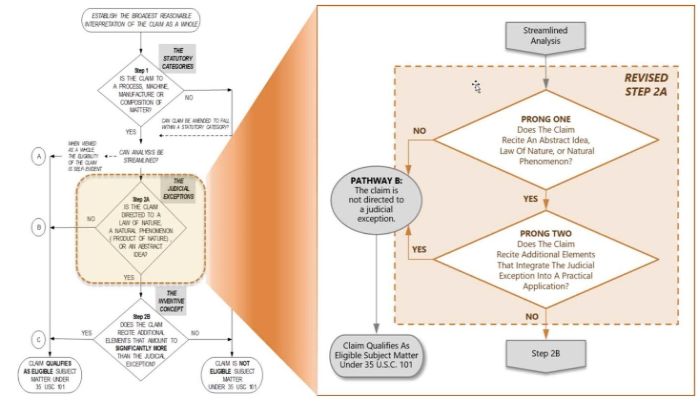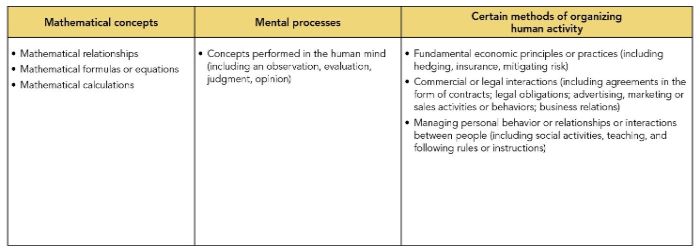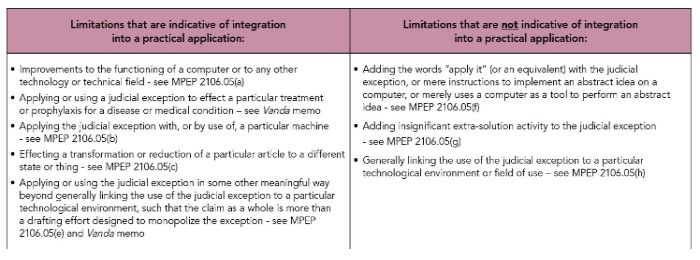Since the Alice decision in 2014, patent eligibility under Section 101 has become a serious concern for innovative leaders attempting to build a strong patent portfolio directed to technology that includes software-related or data processing features, such as AR/VR technology. Because of the unpredictability and genuine threat of one's invention being deemed patent ineligible, the mere association of an invention to software or data processing may scare away potential investors, weaken leverage with potential licensees, and fail to intimidate competitors from infringing. Companies must proactively address potential Section 101 issues through careful and comprehensive patent application drafting that equips them with adequate detail and disclosures that can overcome concerns and provide strong rebuttal arguments.
Companies should understand that they can face 101 challenges at different times throughout the life of a patent. The first hurdle is during review by a patent examiner of a patent application at the USPTO, which includes analyzing whether the claims in the application is directed to a patent ineligible concept (e.g. abstract idea). Once a patent is obtained, its validity can be challenged in judicial tribunal, such as a federal district court or the Patent Trial and Appeal Board, by a third-party through arguments that the patent should be deemed invalid because it is directed to ineligible subject matter. Thus, it is ideal to address any potential 101 issues upfront at the patent drafting stage.
Analytical Framework for Section 101 Challenges
For patent applications relating to software, the immediate confusion after Alice was drastic with a 31% increase in first office action rejections based on Section 101 and 26% increase in the uncertainty in the patent examination process. However, in January 2019, the USPTO provided guidance to address Section 101 issues that reportedly decreased the number of rejections by 25% and the uncertainty by 44% in 2019. While these guidelines are not binding outside of the agency, they are instructive on how a company can approach Section 101 issues in light of Alice.
It is helpful to understand the overall procedural analysis to determine patent eligibility. Patent eligibility is broken down into Step 1 and Step 2. Step 2 is further defined in two parts: Step 2A and Step 2B. Lastly, Step 2A breaks down into two separate prongs:

Step 1 merely involves determining whether the claim meets the statutory requirements of Section 101, which requires the claim to be a "process, machine, manufacture, or composition of matter." Every claim must ft into one of these categories, otherwise, it is not patent eligible.
Step 2 is where the difficulty and confusion arise. First, in Step 2A, it is determined whether the claim is directed toward one of the judicial exceptions: a law of nature, a natural phenomenon, or an abstract idea. Next, in Step 2B, one must show that the claim recites an inventive concept. This article focuses on practical tips to take advantage of Step 2A and avoid Section 101 issues, specifically on how to avoid having claims covering AR/VR concepts being designated abstract.
Step 2A offers two ways for a patentee to avoid Section 101 issues: (i) do not recite an abstract idea in your claims (prong 1) and (ii) ensure any claim that may be deemed to recite an abstract idea has additional elements that integrate the alleged abstract idea into a practical application (prong 2).
For prong 1, there are three common categories of abstract ideas that examiners and courts look toward to see whether a claim limitation recites an abstract idea: mathematical concepts, mental processes, or certain methods of organizing human activity. All three of these examples are at the core of AR/VR applications. Mathematical concepts are instrumental in manipulating data and creating AR/VR environments. Many of the applications surrounding AR/VR implement visualizations of the human mind. And, many industries take advantage of AR/VR to perform previously manual activity in a augmented or virtual manner. Thus, it is especially important that that patentees carefully draft claims directed to AR/VR technologies.

Avoid reciting mathematical concepts in the claim
If mathematical concepts are used as part of the invention, be sure to claim them in a manner that the limitations are based on the concepts, rather than merely reciting the concepts in the claims themselves. In Example 39, provided as part of the USPTO's guidance on how to address Section 101 issues, claim limitations that were based on mathematical concepts were deemed not to recite a mathematical relationship, formula, or calculation because it merely included claim limitations that were based on the mathematical concepts. Contrastingly, the Federal Circuit in In re Gitlin, 775 F. App'x 689, 690 (Fed. Cir. 2019) (non-precedential) found that a claim reciting implementation of interpolation was directed toward a mathematical concept, as evidenced by an encyclopedia. Thus, for drafting claims covering AR/VR technologies, drafters must be mindful of extrapolating any mathematical concepts to the detailed steps of what is happening, as done in Example 39, rather than merely reciting the mathematical concept (e.g. interpolation).
|
USPTO Example 39 Claim Language |
In re Gitlin |
|
A computer-implemented method of training a neural network for facial detection comprising: collecting a set of digital facial images from a database; applying one or more transformations to each digital facial image including mirroring, rotating, smoothing, or contrast reduction to create a modified set of digital facial images; creating a first training set comprising the collected set of digital facial images, the modified set of digital facial images, and a set of digital non-facial images; training the neural network in a first stage using the first training set; creating a second training set for a second stage of training comprising the first training set and digital non-facial images that are incorrectly detected as facial images after the first stage of training; and training the neural network in a second stage using the second
training set. |
A method for efficiently implementing a multi-dimensional interpolation in any number of dimensions, the method comprising: implementing processing said interpolation's third interpolation-input as a recursion. |
Describe in Detail How Extensively Data is Manipulated
To avoid reciting a mental process, the claims cannot include limitations that can be practically performed in the human mind. For instance, in Research Corp. Tech. v. Microsoft, the Federal Circuit found that the claimed method was not a mental process because it was directed toward rendering a halftone image of a digital image by comparing, pixel by pixel, the digital image against a blue noise mask. On the flip side, in Electric Power Grp. V. Alstom, the Court found that the claims recited vague data analysis at a high level of generality such that it could be performed in the human mind. Thus, it is important to capture the complexity any processes described in claim limitations and avoid general data processing that, when broadly read, covers analysis that can be simply done in the human mind.
|
Research Corp. Tech. v. Microsoft, 627 F.3d 859, 868-69 (Fed. Cir. 2010) |
Electric Power Grp. V. Alstom, 830 F.3d 1350, 1353 (Fed. Cir. 2016) |
|
Apparatus for the halftoning of color images comprising a comparator for comparing, on a pixel-by-pixel basis, a plurality of color planes of said color image against a blue noise mask in which the blue noise mask is comprised of a random non-deterministic, non-white noise single valued function which is designed to provide visually pleasing dot profiles when thresholded at any level of said color images, wherein an output of said comparator is used to produce a
halftoned image. |
A method of detecting events on an interconnected electric power grid in real time over a wide area and automatically analyzing the events on the interconnected electric power grid, the method comprising: receiving a plurality of data streams ... receiving data from other power system data sources ... receiving data from a plurality of non-grid data sources; detecting and analyzing events in real-time from the plurality of data streams from the wide area based on at least one of limits, sensitivities and rates of change ... displaying the event analysis results and diagnoses of events and associated ones of the metrics from different categories of data and the derived metrics ... displaying concurrent visualization of measurements from the data streams and the dynamic stability metrics directed to the wide area of the interconnected electric power grid; accumulating and updating the measurements from the data streams and the dynamic stability metrics, grid data, and non-grid data in real time as to wide area and local area portions of the interconnected electric power grid; and deriving a composite indicator of reliability that is an indicator of power grid vulnerability and is derived from a combination of one or more real time measurements or computations of measurements from the data streams and the dynamic stability metrics covering the wide area as well as non-power grid data received from the non-grid data source. |
To further protect claims from Section 101 attacks, patentees should equip themselves with arguments under prong 2 by including additional elements that integrate any alleged abstract idea into a practical application. This requires analyzing limitations individually and as a combination with the rest of the limitations of the claim itself. The key inquiry requires showing a meaningful limitations on the abstract idea so that the claim is not designed to monopolize on the abstract idea. Notably, integration into a practical application can be found even when the elements represent well-understood, routine, conventional elements or activity.

Describe Use and Employment of Abstract Limitations as an Improvement of the Technical Field
To take advantage of prong 2, a patentee must recite additional limitations that capture and utilize the abstract idea in a meaningful manner. In USPTO Example 45, elements (b) and (c) of claim 1 recited abstract ideas because they described mathematical formulas to determine extent of curing and mental processes that could be performed in the human mind by, for example, a scientist or engineer. Next, under prong two analysis, the other claim limitations (i.e. limitation (a) and "controller") did not integrate the abstract idea into a practical application. Limitation (a) was recited with a high level of generality and described mere data gathering. Similarly, "controller" generic recitation represents no more than mere instructions to apply limitations (a)-(c). The physical nature of the controller does not transform this additional limitation into a practical application. Contrastingly, claims 2 (dependent on claim 1) and claim 4 add limitation (d) directed toward sending control signals perform corrective actions by instructing the molding apparatus to perform specific functions (opening and ejecting) once a certain temperature is reached, thus preventing technical issues of undercuring or overcuring of the molding. This limitation meaningfully employs information provided by the abstract limitations to control the operation of the apparatus. Moreover, the claimed controller provides technical improvements in the field of injection molding.
|
USPTO Example 45 Claims 2 and 4 |
USPTO Example 45 Claim 1 |
|
2. The controller of claim 1, which is further configured to: (d) send control signals to the injection molding apparatus once the polyurethane has reached a target percentage, the control signals instructing the apparatus to open the mold and eject the molded polyurethane from the mold. ******************************************************************** 4. A controller for an injection molding apparatus having a mold defining a cavity for receiving uncured polyurethane that is heated to form a molded article during a cycle of operation of the apparatus, the controller configured to: (a) send a control signal to the injection molding apparatus to regulate injection of uncured polyurethane into the mold, and to heat the mold to a target temperature to cure the polyurethane; (b) repeatedly obtain temperature measurements of the mold; (c) compare the obtained temperatures to a target temperature; and (d) maintain temperature of the mold within two degrees of the target temperature by sending a control signal to the apparatus to selectively heat or cool the mold when the obtained temperature of the mold is more than two degrees different than the target temperature. |
1. A controller for an injection molding apparatus having a mold defining a cavity for receiving uncured polyurethane that is heated to form a molded article during a cycle of operation of the apparatus, the controller configured to: (a) repeatedly obtain measurements of the temperature of a mold; (b) calculate an extent of curing completion of polyurethane in the mold using the obtained temperatures and the Arrhenius equation; and (c) determine the extent that the polyurethane is cured as a percentage. |
The tips described above can help insulate claims from Section 101 issues. In Part II, we dive into Step 2B and explain how patentees can draft claims to recite an inventive concept. This will provide even more arguments against Section 101 attacks.
Originally published August 24, 2020.
The content of this article is intended to provide a general guide to the subject matter. Specialist advice should be sought about your specific circumstances.


